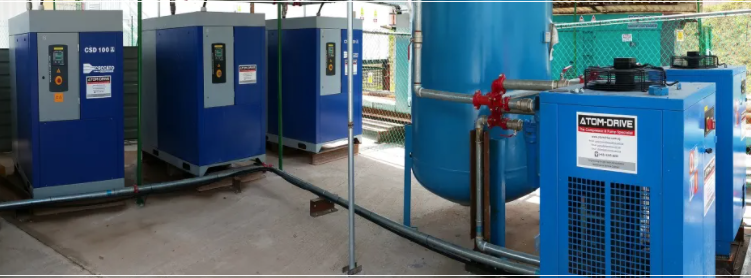Critical Factors to Consider When Designing Your Compressor Room

One common thing that can be easily overlooked is the importance of designing an efficient compressor room. After you’ve determined your overall requirements and selected the appropriate compressor, you can begin designing the layout of your compressor room. For starters, the compressor room should be located in a central location when possible, close to the point of use. This will help to minimize pressure drop as well as reduce installation costs as less piping will be required. If this isn’t possible, try to keep the compressor room close to the larger volume applications in your facility. Otherwise you will have to use larger diameter piping in order to ensure an adequate volume of air is available.
The diameter of the distribution piping should NOT be based on the connection size of the compressors, aftercoolers, or filters. According to the Compressed Air Challenge Best Practices for Compressed Air Systems handbook, piping should be sized so that the maximum velocity in the pipe is 30 ft/sec. When the distance between the compressor room and the point of use is lengthy, consider increasing the pipe diameter to minimize the pressure drop across the system.
Inside of your compressor room you’ll have a variety of different equipment, all dependent on the demand, quality, supply, storage, and distribution of your compressed air. Keeping all of the equipment in its own room will also provide some insulation from the noise associated with compressed air generation. It is crucial that the space selected as your compressor room is sufficiently large enough to accommodate everything without becoming cramped. As a general rule of thumb, keep about 3′ of space between equipment such as the compressor, receiver tanks, aftercooler, and dryer. This helps to prevent equipment from overheating as well as offers maintenance personnel adequate space with which to perform any regularly scheduled maintenance or repairs.
Once you’ve selected your equipment, piping, and determined the location, another thing to consider is ventilation. As compressed air is generated, the compressor gives off a good amount of heat. It is important that the exhaust air is not permitted to re-circulate throughout the compressor room. The exhaust needs to be ducted so that it the warm air is not drawn in at the air intake on the compressor. Some equipment, such as refrigerated dryers, require a substantial amount of cooling air. In these situations, an exhaust fan can be used to provide that additional airflow.
To further enhance the efficiency of your facility, the heat generated from compression can be re-purposed instead of simply exhausting into the ambient environment. This process is commonly referred to as compressed air energy recovery. Some industries require a source of heat for many of their manufacturing processes. In these scenarios, the heat energy that is produced during compression can be reused rather than having to generate another source of heated air. If the heated air can’t be used for any of your manufacturing processes, the heat can be used as a means to heat your water supply or even to heat the facility itself. This can drastically reduce your electricity or gas requirements during cooler periods.
To reduce the amount of required maintenance and ensure that your compressor is operating as efficiently as possible, the compressed air intake must also be free from particulate and harmful gases. When dust and dirt is drawn into the compressor, it can cause wear on the internal components. If the ambient environment contains a lot of dust and particulate, a pre-filter can be used to prevent any future problems. In these instances, it is important to consider the pressure drop that will be caused when designing the system.
Keeping these tips in mind will serve to make your life much easier in the long run. Once you have everything installed and set up, visit the EXAIR website or give us a call to speak with an Application Engineer. EXAIR’s Intelligent Compressed Air Products can help you reduce compressed air consumption and increase worker safety by adhering to both OSHA 1910.242(b) and 1910.95.
Tyler Daniel
Application Engineer
E-mail: TylerDaniel@exair.com
Twitter: @EXAIR_TD
Image Courtesy of thomasjackson1345 Creative Commons Attribution-NoDerivs 2.0 Generic (CC BY-ND 2.0)



